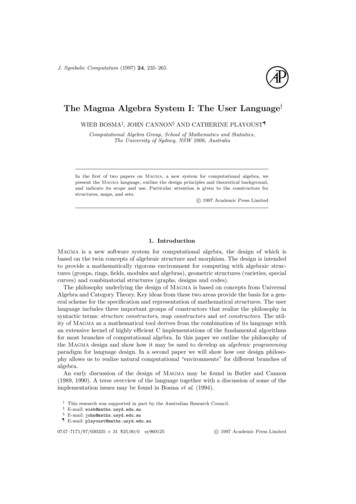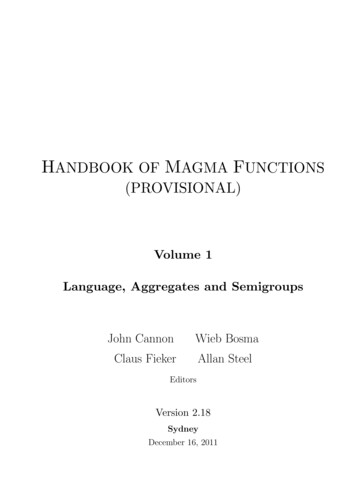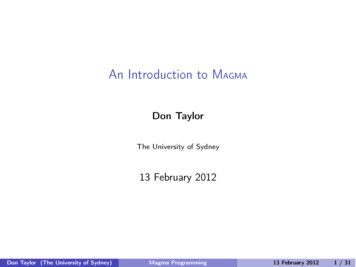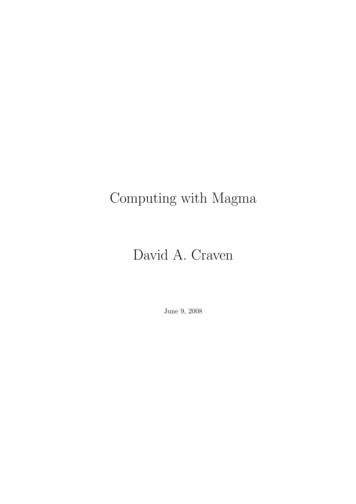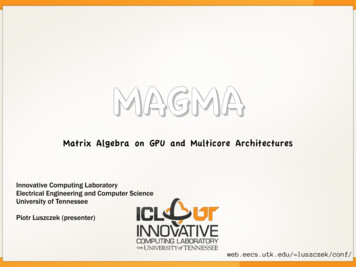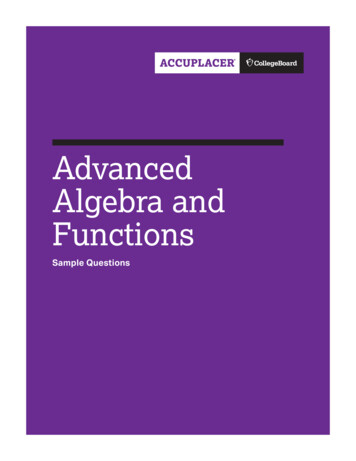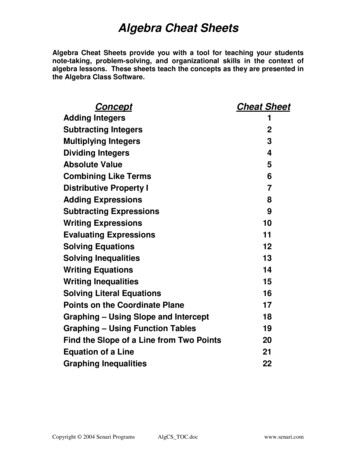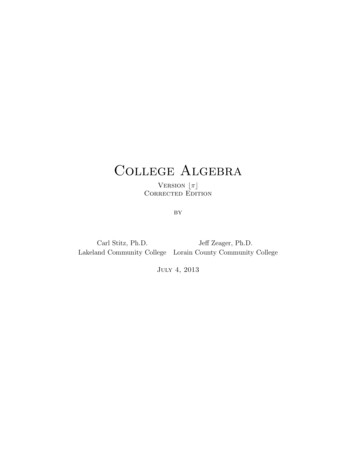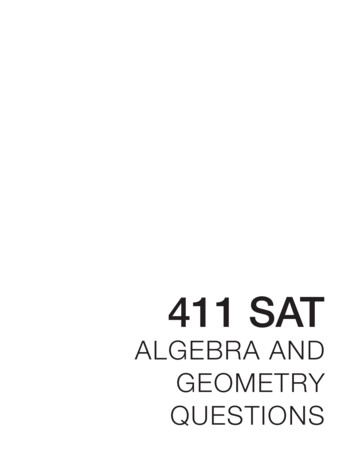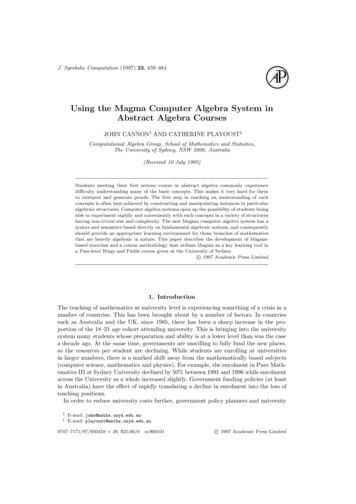
Transcription
J. Symbolic Computation (1997) 23, 459–484Using the Magma Computer Algebra System inAbstract Algebra CoursesJOHN CANNON† AND CATHERINE PLAYOUST‡Computational Algebra Group, School of Mathematics and Statistics,The University of Sydney, NSW 2006, Australia(Received 10 July 1995).Students meeting their first serious course in abstract algebra commonly experiencedifficulty understanding many of the basic concepts. This makes it very hard for themto interpret and generate proofs. The first step in reaching an understanding of suchconcepts is often best achieved by constructing and manipulating instances in particularalgebraic structures. Computer algebra systems open up the possibility of students beingable to experiment rapidly and conveniently with such concepts in a variety of structureshaving non-trivial size and complexity. The new Magma computer algebra system has asyntax and semantics based directly on fundamental algebraic notions, and consequentlyshould provide an appropriate learning environment for those branches of mathematicsthat are heavily algebraic in nature. This paper describes the development of Magmabased exercises and a course methodology that utilizes Magma as a key learning tool ina Pass-level Rings and Fields course given at the University of Sydney.c 1997 Academic Press Limited1. IntroductionThe teaching of mathematics at university level is experiencing something of a crisis in anumber of countries. This has been brought about by a number of factors. In countriessuch as Australia and the UK, since 1985, there has been a sharp increase in the proportion of the 18–21 age cohort attending university. This is bringing into the universitysystem many students whose preparation and ability is at a lower level than was the casea decade ago. At the same time, governments are unwilling to fully fund the new places,so the resources per student are declining. While students are enrolling at universitiesin larger numbers, there is a marked shift away from the mathematically based subjects(computer science, mathematics and physics). For example, the enrolment in Pure Mathematics III at Sydney University declined by 50% between 1991 and 1996 while enrolmentacross the University as a whole increased slightly. Government funding policies (at leastin Australia) have the effect of rapidly translating a decline in enrolment into the loss ofteaching positions.In order to reduce university costs further, government policy planners and university†‡E-mail: john@maths.usyd.edu.auE-mail: playoust@maths.usyd.edu.au0747–7171/97/050459 26 25.00/0sy960101c 1997 Academic Press Limited
460J. J. Cannon and C. Playoustadministrators are seeking ways of increasing the productivity of university teachers. Inparticular, the computer has been identified by these groups as a means of enhancingthe efficiency of university teaching, and various government initiatives in Australia, theUK and the USA encourage investment in computer-based teaching facilities. While thecomputer undoubtedly has a great deal to contribute to student learning at university,its effectiveness in contributing to teaching the more abstract parts of mathematics hasyet to be established. In this paper we present our experience in applying computertechnology to the teaching of genuinely abstract mathematics, as distinct from teaching“method courses” in calculus or linear algebra.There are a number of different modes in which the computer may contribute to studentlearning in a mathematics course. These include:(a) As a tool for performing tedious numerical calculations in such courses as concretelinear algebra, discrete mathematics, elementary calculus, numerical analysis, andstatistics.(b) As a means of delivering the formal content of the course. Increasingly, people arelooking at hypertext documents as the vehicle for presenting content. This is alsobeing driven by various initiatives to greatly expand the educational possibilities foroff-campus education (distance learning), a move which has recently become veryattractive because of the possibility of delivering the material over the Internet,thereby making newly prepared material instantly available.(c) The exploitation of computer graphics to illustrate complex phenomena visually(e.g., the behaviour of the solutions of a differential equation).(d) As a means of enabling students to create and explore complex mathematical structures that are represented symbolically.Some approaches combine more than one of these modes. The type (a) application is increasingly widely used with considerable success, both at Sydney University and at manyother institutions. It was the goal of the work reported here to study the effectivenessof approach (d) to the teaching of abstract material to a large group of Pass students,most of whom were studying mathematics not out of any innate interest in the subject,but rather because of its requirement for their degree program, or as a co-requisite forother subjects. Our chosen course was a beginning course on Rings and Fields deliveredto third-year (i.e., final-year) Pass students. This particular course was selected sincetraditionally students have experienced considerable difficulty in mastering many of theconcepts.The first course in abstract algebra is often a considerable shock for many students.It is the case at Sydney University, and undoubtedly also at other universities, that inmathematics courses commonly taken prior to abstract algebra, most of the ideas metare reasonably close to something students can visualize. Also, there is usually sufficientemphasis on semi-mechanical processes, such as solving a particular class of differentialequations, so as to enable students to obtain a significant amount of credit in the finalexamination by mastering such processes. On the other hand, many students experiencegreat difficulty in approaching abstract algebra. (Here we characterize abstract algebrainformally as the study of axiomatically defined structures, where the basic structuresof interest at the elementary level are groups, rings and fields.) The immediate problemis that of grasping the idea of a structure defined axiomatically, since it is very difficult
Using the Magma Computer Algebra System in Abstract Algebra Courses461to relate the notion of “ring”, say, to any intuitive notions. (This is in contrast to thesituation in a course on elementary linear algebra, where the idea of a vector spacewill be grounded in the students’ notion of ordinary 3-dimensional space). Despite facingdifficulties in grasping concepts, the students are expected to read and understand formalmathematical proofs for the first time. Finally, they are expected to be able to synthesizeshort proofs of simple exercises growing out of the material presented by the lecturer.An important step in the process of mastering such material involves studying how theabstract concepts and ideas are realized in the context of particular instances of algebraicstructures. In this way, students can learn by empirical discovery, rather as in a sciencepractical class. However, for Pass students, lack of time and lack of computational skillform practical barriers to such experimentation in all but the most trivial situations.The advent of computers together with the subsequent development of computer algebra systems opens up the possibility of providing students with the means by which theymay easily and conveniently construct and manipulate non-trivial examples in abstractalgebra. This approach has been explored by a number of educators. Thus, Cannon developed computer tutorials based on the use of Cayley (Cannon, 1984) in a second-yearHonours-level Group Theory course in 1975 (see below). Sherman (O’Bryan and Sherman, 1992; Sherman, 1993; Patrick et al., 1993; Belcastro and Sherman, 1994; Sherman,1996) has used both Cayley and Magma very successfully in workshops for very brightundergraduates in which the computer is used by the students to discover facts aboutgroups which they then try to prove. Boston used Cayley in a manner similar to Sherman with a graduate class in group theory at Urbana. [See Boston et al. (1993) for apublication that resulted from the Cayley experimentation.] Instructors have used Mapleand Mathematica for other areas of algebra. However, systems such as Maple, MACSYMA, Mathematica and REDUCE all suffer from the drawback that their model ofmathematics is largely inappropriate for a person studying algebra. Thus, the studentlearning algebra with the aid of such a system is confronted with the problem of mastering both abstract algebra and a system which views algebra quite differently to thestandard textbook approach. The recent development of Magma (Bosma and Cannon,1995; Bosma et al., 1994, 1995; Butler and Cannon, 1989, 1990; Cannon and Playoust,1995) provides us for the first time with a system that is specifically designed for abstractalgebra and in which the data types are the fundamental notions of algebra: algebraicstructures (magmas), sets, sequences and mappings.In 1995, the authors undertook to develop Magma courseware for use in abstractalgebra courses. Unlike in the case of the work of Boston, Cannon and Sherman mentionedabove, in which computer-assisted learning was introduced for very bright students, thepurpose of this study was to develop effective computer-assisted learning based on the useof computer algebra systems for large classes of students that are both poorly preparedand lacking motivation. This paper reports on the experience of using Magma as part ofthe learning environment for the Rings and Fields course taught to third-year Pass-levelstudents in 1995 and 1996.Magma has also been used at Sydney to teach vector spaces, an elementary coursein group theory and an advanced course on computational algebra. Sherman at RoseHulman has used Magma to teach courses in group theory, coding theory and discretemathematics.
462J. J. Cannon and C. Playoust2. The Use of Computers in Abstract Algebra CoursesMathematics students of average ability have difficulty in developing their understanding of abstract algebra at a reasonable rate through a traditional approach to the material. They find it difficult to understand objects that are defined axiomatically, theyhave great difficulty in understanding “second-order” concepts such as that of quotientstructure in which a set of elements belonging to one structure suddenly becomes a singleelement of the quotient structure, and they struggle with the analysis and synthesis ofproofs. Without a good grasp of the basic ideas, students cannot hope to understand thetheorems and proofs presented to them, let alone create their own hypotheses or formulate proofs of these hypotheses or textbook problems. Perhaps the single most importantway of making the material more approachable is to study examples of the structuresand their relationships. Students are keen for this kind of help, often making complaintsand requests such as:Too much theory (definitions, proofs etc) and not enough numeric examples toillustrate principles.More practical examples using real equations and numbers, not algebraic notationplease!The second quotation, especially, illustrates the concrete nature of their thinking; anequation is not considered genuine unless its constituents are numbers rather than algebraic symbols.In pen-and-paper work, constraints of time and calculation errors prohibit the use ofany but trivially small examples. This makes it hard to provide worthwhile experience inworking with the concepts in particular structures. Moreover, the students are less likelyto appreciate the role of experiment in the discovery of new theorems. Computers canbe beneficial in these areas.The use of a computer allows students to work with larger examples, without thetedium of excessive computation by hand. For instance, they can work towards comprehending the notion of quotient structure by manipulating the entire equivalence classesconstituting its elements (in the case of a quotient of a finite structure). They can complete more examples in a given amount of time, rather than suffering the frustrationof completing only one instance of (say) the Euclidean algorithm for polynomials in a50 minute tutorial session because of errors. Freed from having to concentrate on gettingthe mechanical details of the arithmetic correct, students have a chance to perceive theunderlying principles (Neuwirth, 1987).A benefit flowing from this ability to construct and manipulate examples with ease isthe opportunity to learn by discovery. Having explored several related examples (whetherthey be the elements of a single ring, or several rings in the same category), the studentscan identify the similarities and differences and postulate reasons for their observations.After testing their hypotheses by a judicious choice of additional examples, they canproceed to prove them. This will mimic, in a shorter time-span and with fewer falseturnings, the manner in which the mathematics was initially discovered. Active learningof this kind can be far more effective than merely receiving from on high a collectionof unmotivated definitions and unintuitive theorems. Lane et al., (1986) discuss howthey have used computer-based discovery methods such as these in lower undergraduatemathematics courses. (In the Rings and Fields course the discovery was highly assisted,in the sense that strong hints were given to the students as to what should be observed.
Using the Magma Computer Algebra System in Abstract Algebra Courses463It was hoped that they would develop intuition about the mathematical properties worthseeking.)An auxiliary reason to employ computers in modern tertiary mathematics courses liesin the very existence of computer algebra software that is widely used by mathematicians,If students subsequently have occasion to use the theory they were taught at university,it is highly likely tha
algebraic structures. Computer algebra systems open up the possibility of students being able to experiment rapidly and conveniently with such concepts in a variety of structures having non-trivial size and complexity. The new Magma computer algebra system has a syntax and semantics based directly on fundamental algebraic notions, and consequently
